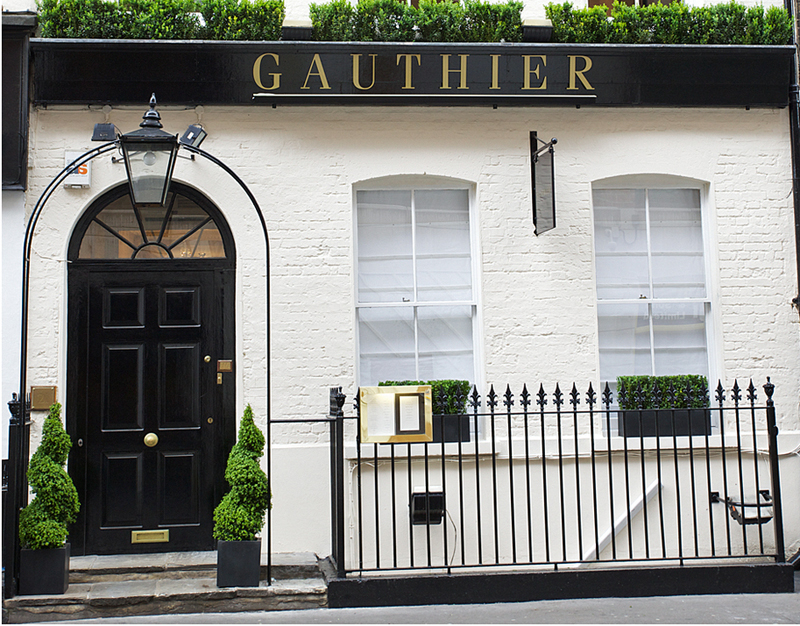
Passion, Precision and Perfection are epithets justifiably applied to Alexis Gauthier’s gastronomy. Since opening Gauthier Soho in 2010 and receiving plaudits from all the major guides, his restaurant has gone from strength to strength, delighting guests with exquisite cuisine, comfortable surroundings and highly professional service. To achieve all three simultaneously, especially the last given the lamentable decline in standards euphemistically dubbed relaxed formality, has become a rarity in the world of fine dining.
Set in a five storey terraced Georgian townhouse in Romilly Street, Gauthier Soho is a miniature maze of narrow staircases, uneven floors and varying sized dining rooms. This, indeed, is one of its many virtues – its smallness and intimacy. Ringing the bell of the glossy black door ensures a personal welcome before guests are shown to either of the two dining rooms – the Petit Salon on the ground floor or the Grand Salon on the first. (There are also two private dining rooms at the top of the staircase and a Chefs’ Room / wine cellar on the ground floor.) The high ceilinged, thickly carpeted rooms feature large gilt framed mirrors above the original marble fireplaces. Plain white walls form the backdrop to eclectic paintings and objets d’art. At lunch, ample natural light comes from the sash windows fitted with colourful floral blinds. In the evening, clever spotlighting supplements the dimly candlelit tables. Upholstered chairs in beige and well-spaced tables dressed in fine linen with monogramed napkins complete the elegantly designed salons.
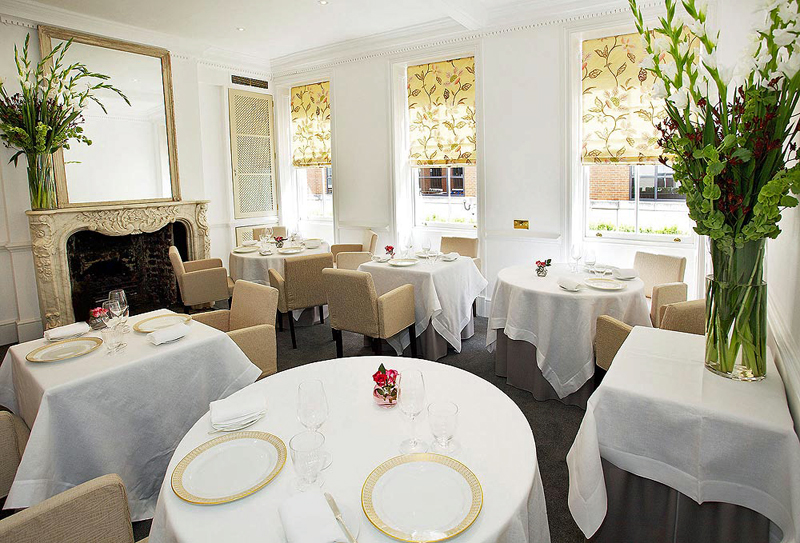
A disciple of triple starred Alain Ducasse at his Louis XV restaurant in Monaco (1993-6), Alexis Gauthier progressed to gaining his own Michelin star in 2000 at Roussillon in Pimlico, where he was head chef from 1998 to 2010. After opening Gauthier Soho in 2010 – which used to be Richard Corrigan’s Lindsay House – another star followed after a year.
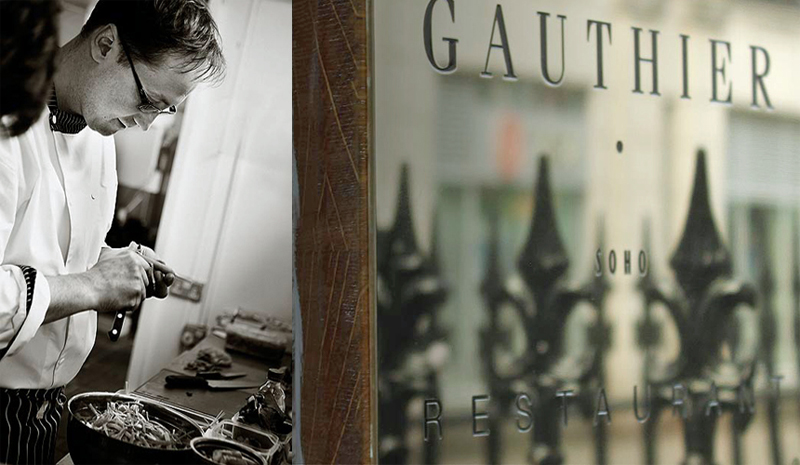
Passion is shown in Alexis’ inexhaustible creativity whilst being true to his classical roots. Invention is tempered with a sensitive caution, leading to unusual yet harmonious combinations in taste, texture and colour. Equal attention is paid to vegetables – Vegetronic, is his latest cookbook – as to meat and fish in the composition of dishes. Vegan dishes – highlighted in his Menu Les Plantes – also warrant serious consideration: where else amongst high end restaurants, could one eat a dish such as Tofu & Swiss chard gratin with roast garlic purée, crispy garlic & herb salad?
Precision comes from the accuracy of timing in cooking and in the balance of delicate flavours and contrasting textures. Uniquely amongst top chefs, Alexis rejects pre-weighing and timing in favour of judging by touch and sight. Such an instinctive approach demands far greater skill from his brigade of ten chefs. Where figures are called for, however, is in the calorie count for each dish, which is clearly indicated on the menu.
Perfection in the finished product is guaranteed. Menus change with the seasons, the ingredients being impeccably sourced. Generosity of spirit is evident in abundance: all dishes, even the smaller ones, are multi component, with distinct tastes identifiable. A conscious artistry is shown in their beautiful presentation. Attention to detail at every stage, from the dainty canapes with parmesan tuiles, through home baked breads to the delicious petit fours, is exemplary.
Nor is perfection confined to the food. The front of house team of nine, overseen by the understated resilience of restaurant manager Pierre Dumoulin, conduct a seamless operation, especially impressive given the cramped conditions and awkward shape of the rooms. Commis waiters negotiate the narrow staircase from the basement kitchen with sprightly step, allowing senior staff to present the dishes with considered aplomb. Service is correctly formal but not stiff, polite but not ingratiating, informative but not condescending. A suitable interval is allowed between courses, with diners’ requests often being anticipated – perhaps the acid test of excellent service.
With three sommeliers headed by Perrick Chapel, wines are taken seriously. The “dynamic and exciting” mainly French and Italian wine list avoids excessive mark ups. The restaurant also has its own thriving wine club. Assistant sommelier Domenico Barbieri, who served us presented, the flight of wines concisely, showing a real engagement with his craft.
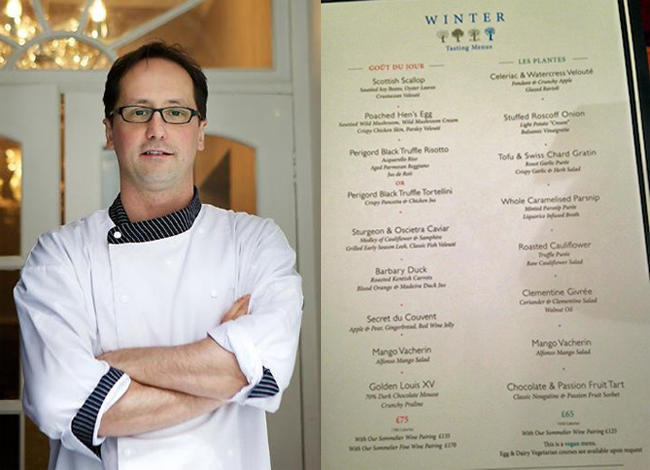
The menu structure and price point are highly appealing, both gastronomically and financially. The carte, with three or four options at each stage, finishing with cheese or dessert, offers three, four or five courses for £50, £60 and £70 respectively. It is also possible to mix and match dishes from the same course. An eight course tasting menu, the Gout du Jour, featuring smaller versions of dishes from the carte, is competitively priced at £75. The vegan menu, Les Plantes, is £65, with wines pairings an extra £60 for each menu. Even better value can be had at lunch, where three courses with champagne, two glasses of wine and coffee is £45, or a four course tasting menu with champagne aperitif for the same price. Nor should we forget the free still or sparkling filtered water which is often charged for in lesser establishments. Certainly, no other high end West restaurant can match Gauthier Soho for prices and quality.
Fine Dining Guide visited on a busy Friday evening in early March to sample the tasting Gout du Jour.
Well-made canapes served with an aperitif showed minute attention to detail. Delicate tapioca crisps with cod roe mousse, roasted celeriac with horseradish and ricotta and herbs tartelettes served their purpose in tantalising the palate with mouthful explosions of flavour without stealing the thunder of the courses to come.
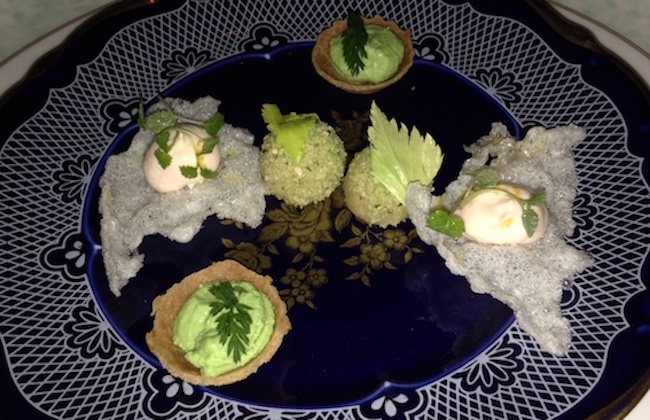
A selection of freshly baked breads, served with a generous pat of unsalted Normandy butter, included sour dough, basil and tomato focaccia, pain au lait with parmesan and red onions, and wild garlic brioche. They were exemplary in their crisp crusts, firm crumb and heady aromas and equally accomplished as those produced at Le Champignon Sauvage.
The first course saw a plump Scottish scallop, seared to produce a caramelised crust with meltingly soft, translucent flesh. Sauteed soya beans and oyster leaves added contrasting texture and freshness, whilst a deeply flavoured crustacean veloute, incorporating the scallop coral, lifted the dish. The firm acidity of the chosen dry white wine partnered the seafood well. (Wine: Savennieres-Roche-aux-Moines 2013, Domaine aux Moines)
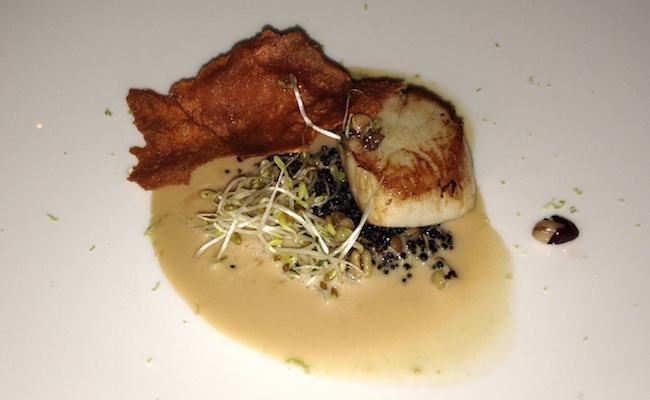
Next came a delicately poached hen’s egg, its golden yolk cascading over sautéed wild enoki mushrooms, wild mushroom cream and a dashi emulsion. These soft, earthy elements were balanced by a light parsley veloute and crisp chicken skin. The lively fruit flavours and juicy acidity of the paired wine worked well with this dish. (Wine: Alsace Pinot Gris 2013, Domaine Josmeyer <Le Fromenteau>)

The third course featured a signature dish for which the restaurant has become renowned. An intensely fragrant Perigord black truffle risotto made from Acquarello rice, which absorbs more stock than other varieties without reducing it to a shapeless mush, was rich, creamy and moreish. Enhanced by aged Parmesan Reggiano, and Jus de roti, the earthy depth of flavour was stunning. The sherry- like Jura wine, with its spicy, almondy finish, was another inspired pairing. (Wine: Cotes du Jura 2012, Domaine Daniel Dugois)
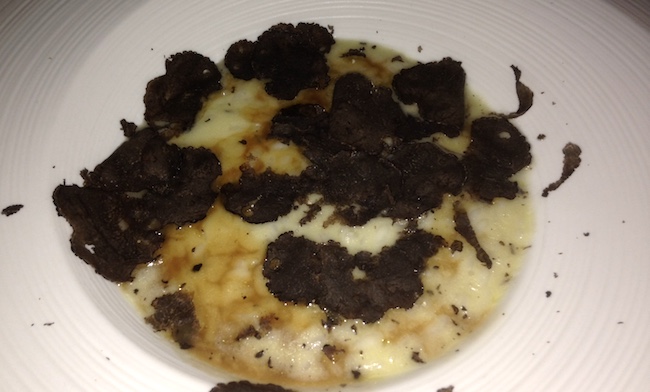
It was interesting and unusual to be offered Sturgeon for the fish course. The pronounced piscine flavour and soft texture of this freshwater fish, timed to retain its succulence, was balanced by the relative subtlety of crisp cauliflower florets and smokiness of grilled early season leek. This dish was finished with a classic fish veloute and an appropriate luxurious garnish of Oscietra caviar. The light Pinot Noir style of the Austrian wine proved a suitable match. (Wine: Weinland 2014, Domaine Gutt Auggau <Atanasius>)
The meat course showcased the deep, sweet gamey flavour of Barbary duck in two ways. The thick breast, roasted to a medium rare, and shredded, meltingly soft confit leg. Garnished with roasted Kentish carrots and finished with a silky blood orange puree and a rich Madeira duck jus which lifted the whole dish, this was a simple yet accomplished dish. The full bodied red wine, high in tanin, complemented it well. (Wine: Coteaux du Languedoc-Montpeyroux 2003, Domaine Alan Chabanon < L’esprit de Font Caude>)
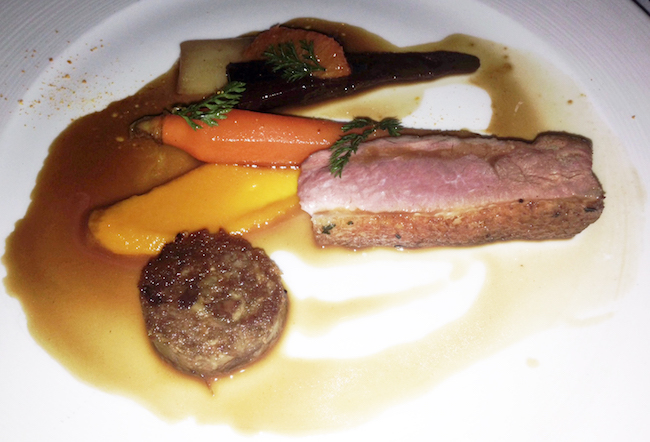
The cheese course presented a slice of the unusual Secret du Couvent with its dense, semi firm texture and heady fragrance. Gingerbread, tiny apple and pear balls with red wine jelly and a balsamic reduction set off the creamy savouriness of the cheese, as did the caramel notes of the accompanying dry Madeira. (Wine: Madeira 10 yrs, Blandy’s <Sercial>)
Mango vacherin demonstrated the undoubted strengths of the pastry section. A golf ball size of crisp, delicately thin French meringue encased an aromatic sorbet of Alfonso mango. Dressed with drops of mango coulis and tiny cubes of fresh mango given a herbal lift, this light, refreshing dessert, partnered with a sweet New Zealand Riesling was a fitting prelude to the richer finale to come. (Wine: Marlborough Valley 2014, Framlingham <Select Riesling>)
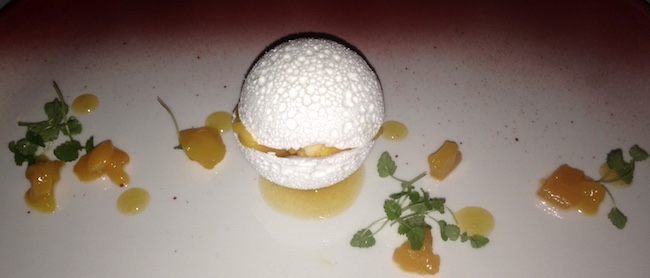
Not having dined at Louis XV in Monaco, my first acquaintance with its eponymous dessert was by watching a TV programme in which Alexis Gauthier, who was Alain Ducasse’s pastry chef, championed it as the greatest dish in the world. If imitation is the sincerest form of flattery, Alexis makes no apology for making it his signature dessert. Having eaten it several times at Gauthier Soho, I can see why it is seen as a dessert lover’s dream. Discs of crisp praline dacquoise topped with a 70% dark chocolate mousse, enveloped in a glossy ganache paradis and decorated with gold leaf formed this rich but light confection that oozed elegant, sophisticated indulgence. Although it is notoriously difficult to pair chocolate with wine, the selected Uraguayan sweet red, combining two different techniques for dessert wines, Barolo Chinato and Marsala, proved a perfect match. (Wine: Calenons N-V, Vinendo de los Vientos <Alcyone>)
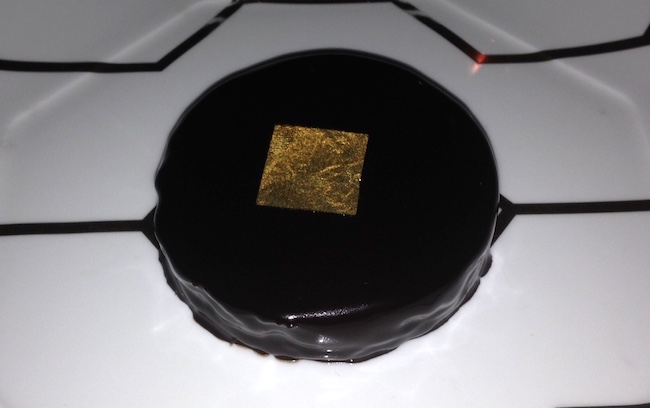
Good coffee and petit fours completed this memorable meal, enhanced by the select flight of wines and impeccable service.
Why Michelin decided to withdraw its star defies belief. Not that Gauthier Soho needs a star to attract custom – it has already proven its worth. Certainly, the healthy numbers of diners, on average 25-30 for lunch and 45-50 for dinner, amongst whom there are a high proportion of regulars, testify to its success. Nevertheless, in the often unintelligible and unfair world of restaurant guides, a major injustice remains uncorrected. Fine Dining Guide will continue to visit this remarkable restaurant, and will follow its progress with interest.



